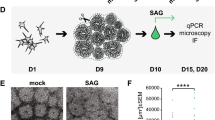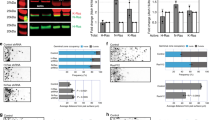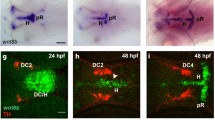Abstract
Neural stem cells that continue to produce neurons are retained in the adult hippocampal dentate gyrus. The mechanisms by which embryonic neural progenitors expand and transform into postnatal neural stem cells, an essential process for the continual production of neurons throughout life, remain unknown. We found that radial astrocytes, the postnatal progenitors in the dentate gyrus, failed to develop after embryonic ablation of ciliary genes or Smoothened (Smo), an essential component for Sonic hedgehog (Shh) signaling. Postnatal dentate neurogenesis failed in these mutant mice, and the dentate gyrus became severely hypotrophic. In contrast, expression of a constitutively active Smo (SmoM2-YFP) resulted in a marked expansion of the dentate gyrus. Double-mutant analyses suggested that both wild-type Smo and SmoM2-YFP function through the primary cilia. We conclude that Shh signaling, acting through the primary cilia, has a critical role in the expansion and establishment of postnatal hippocampal progenitors.
This is a preview of subscription content, access via your institution
Access options
Subscribe to this journal
Receive 12 print issues and online access
$209.00 per year
only $17.42 per issue
Buy this article
- Purchase on Springer Link
- Instant access to full article PDF
Prices may be subject to local taxes which are calculated during checkout






Similar content being viewed by others
References
Altman, J. & Bayer, S.A. Migration and distribution of two populations of hippocampal granule cell precursors during the perinatal and postnatal periods. J. Comp. Neurol. 301, 365–381 (1990).
Li, G. & Pleasure, S.J. Morphogenesis of the dentate gyrus: what we are learning from mouse mutants. Dev. Neurosci. 27, 93–99 (2005).
Filippov, V. et al. Subpopulation of nestin-expressing progenitor cells in the adult murine hippocampus shows electrophysiological and morphological characteristics of astrocytes. Mol. Cell. Neurosci. 23, 373–382 (2003).
Fukuda, S. et al. Two distinct subpopulations of nestin-positive cells in adult mouse dentate gyrus. J. Neurosci. 23, 9357–9366 (2003).
Seri, B., Garcia-Verdugo, J.M., McEwen, B.S. & Alvarez-Buylla, A. Astrocytes give rise to new neurons in the adult mammalian hippocampus. J. Neurosci. 21, 7153–7160 (2001).
Rosenbaum, J.L. & Witman, G.B. Intraflagellar transport. Nat. Rev. Mol. Cell Biol. 3, 813–825 (2002).
Davis, E.E., Brueckner, M. & Katsanis, N. The emerging complexity of the vertebrate cilium: new functional roles for an ancient organelle. Dev. Cell 11, 9–19 (2006).
Scholey, J.M. & Anderson, K.V. Intraflagellar transport and cilium-based signaling. Cell 125, 439–442 (2006).
Singla, V. & Reiter, J.F. The primary cilium as the cell's antenna: signaling at a sensory organelle. Science 313, 629–633 (2006).
Haycraft, C.J. et al. Gli2 and Gli3 localize to cilia and require the intraflagellar transport protein polaris for processing and function. PLoS Genet. 1, e53 (2005).
Huangfu, D. & Anderson, K.V. Cilia and Hedgehog responsiveness in the mouse. Proc. Natl. Acad. Sci. USA 102, 11325–11330 (2005).
Huangfu, D. et al. Hedgehog signaling in the mouse requires intraflagellar transport proteins. Nature 426, 83–87 (2003).
Liu, A., Wang, B. & Niswander, L.A. Mouse intraflagellar transport proteins regulate both the activator and repressor functions of Gli transcription factors. Development 132, 3103–3111 (2005).
May, S.R. et al. Loss of the retrograde motor for IFT disrupts localization of Smo to cilia and prevents the expression of both activator and repressor functions of Gli. Dev. Biol. 287, 378–389 (2005).
Corbit, K.C. et al. Vertebrate Smoothened functions at the primary cilium. Nature 437, 1018–1021 (2005).
Rohatgi, R., Milenkovic, L. & Scott, M.P. Patched1 regulates hedgehog signaling at the primary cilium. Science 317, 372–376 (2007).
Badano, J.L., Mitsuma, N., Beales, P.L. & Katsanis, N. The ciliopathies: an emerging class of human genetic disorders. Annu. Rev. Genomics Hum. Genet. 7, 125–148 (2006).
Davenport, J.R. et al. Disruption of intraflagellar transport in adult mice leads to obesity and slow-onset cystic kidney disease. Curr. Biol. 17, 1586–1594 (2007).
Alvarez-Buylla, A., Garcia-Verdugo, J.M. & Tramontin, A.D. A unified hypothesis on the lineage of neural stem cells. Nat. Rev. Neurosci. 2, 287–293 (2001).
Doetsch, F., Garcia-Verdugo, J.M. & Alvarez-Buylla, A. Cellular composition and three-dimensional organization of the subventricular germinal zone in the adult mammalian brain. J. Neurosci. 17, 5046–5061 (1997).
Kozminski, K.G., Beech, P.L. & Rosenbaum, J.L. The Chlamydomonas kinesin-like protein FLA10 is involved in motility associated with the flagellar membrane. J. Cell Biol. 131, 1517–1527 (1995).
Rickmann, M., Amaral, D.G. & Cowan, W.M. Organization of radial glial cells during the development of the rat dentate gyrus. J. Comp. Neurol. 264, 449–479 (1987).
Zhuo, L. et al. hGFAP-cre transgenic mice for manipulation of glial and neuronal function in vivo. Genesis 31, 85–94 (2001).
Pleasure, S.J., Collins, A.E. & Lowenstein, D.H. Unique expression patterns of cell fate molecules delineate sequential stages of dentate gyrus development. J. Neurosci. 20, 6095–6105 (2000).
Brown, C.L. et al. Kinesin-2 is a motor for late endosomes and lysosomes. Traffic 6, 1114–1124 (2005).
Le Bot, N., Antony, C., White, J., Karsenti, E. & Vernos, I. Role of xklp3, a subunit of the Xenopus kinesin II heterotrimeric complex, in membrane transport between the endoplasmic reticulum and the Golgi apparatus. J. Cell Biol. 143, 1559–1573 (1998).
Haraguchi, K., Hayashi, T., Jimbo, T., Yamamoto, T. & Akiyama, T. Role of the kinesin-2 family protein, KIF3, during mitosis. J. Biol. Chem. 281, 4094–4099 (2006).
Murcia, N.S. et al. The Oak Ridge Polycystic Kidney (orpk) disease gene is required for left-right axis determination. Development 127, 2347–2355 (2000).
Moyer, J.H. et al. Candidate gene associated with a mutation causing recessive polycystic kidney disease in mice. Science 264, 1329–1333 (1994).
Delous, M. et al. The ciliary gene RPGRIP1L is mutated in cerebello-oculo-renal syndrome (Joubert syndrome type B) and Meckel syndrome. Nat. Genet. 39, 875–881 (2007).
Vierkotten, J., Dildrop, R., Peters, T., Wang, B. & Ruther, U. Ftm is a novel basal body protein of cilia involved in Shh signalling. Development 134, 2569–2577 (2007).
Chizhikov, V.V. et al. Cilia proteins control cerebellar morphogenesis by promoting expansion of the granule progenitor pool. J. Neurosci. 27, 9780–9789 (2007).
Ahn, S. & Joyner, A.L. In vivo analysis of quiescent adult neural stem cells responding to Sonic hedgehog. Nature 437, 894–897 (2005).
Goodrich, L.V., Milenkovic, L., Higgins, K.M. & Scott, M.P. Altered neural cell fates and medulloblastoma in mouse patched mutants. Science 277, 1109–1113 (1997).
Machold, R. et al. Sonic hedgehog is required for progenitor cell maintenance in telencephalic stem cell niches. Neuron 39, 937–950 (2003).
Mao, J. et al. A novel somatic mouse model to survey tumorigenic potential applied to the Hedgehog pathway. Cancer Res. 66, 10171–10178 (2006).
Bagri, A. et al. The chemokine SDF1 regulates migration of dentate granule cells. Development 129, 4249–4260 (2002).
Lai, K., Kaspar, B.K., Gage, F.H. & Schaffer, D.V. Sonic hedgehog regulates adult neural progenitor proliferation in vitro and in vivo. Nat. Neurosci. 6, 21–27 (2003).
Haycraft, C.J. et al. Intraflagellar transport is essential for endochondral bone formation. Development 134, 307–316 (2007).
Matsuura, K., Lefebvre, P.A., Kamiya, R. & Hirono, M. Kinesin-II is not essential for mitosis and cell growth in Chlamydomonas. Cell Motil. Cytoskeleton 52, 195–201 (2002).
Miller, M.S. et al. Mutant kinesin-2 motor subunits increase chromosome loss. Mol. Biol. Cell 16, 3810–3820 (2005).
Ferrante, M.I. et al. Oral-facial-digital type I protein is required for primary cilia formation and left-right axis specification. Nat. Genet. 38, 112–117 (2006).
Kondo, S. et al. KIF3A is a new microtubule-based anterograde motor in the nerve axon. J. Cell Biol. 125, 1095–1107 (1994).
Muresan, V., Lyass, A. & Schnapp, B.J. The kinesin motor KIF3A is a component of the presynaptic ribbon in vertebrate photoreceptors. J. Neurosci. 19, 1027–1037 (1999).
Marszalek, J.R. et al. Genetic evidence for selective transport of opsin and arrestin by kinesin-II in mammalian photoreceptors. Cell 102, 175–187 (2000).
Long, F., Zhang, X.M., Karp, S., Yang, Y. & McMahon, A.P. Genetic manipulation of hedgehog signaling in the endochondral skeleton reveals a direct role in the regulation of chondrocyte proliferation. Development 128, 5099–5108 (2001).
Acknowledgements
We are grateful to L.S. Goldstein for providing us with the Kif3a conditional mutant mice, N. Murcia for Ift88orpk mice, and J. Reiter and D. Rowitch for Smo and SmoM2 conditional mutant mice and PtclacZ/+ mice. We thank R. Ihrie, D. Lim, S. Pleasure, J. Reiter and C. Yaschine on the manuscript. The work was supported by a Mark Linder/American Brain Tumor Association Fellowship to Y.-G.H. and by grants (NS28478 and HD32116) from the US National Institutes of Health and a grant from the Goldhirsh foundation to A.A.-B. N.S. was supported by the Human Frontier Science Program and the Agence Nationale de la Recherche. Confocal microscopy at Diabetes Endocrinology Research Center Microscopy and Imaging Core was supported by an US National Institute of Health grant (P30 DK063720).
Author information
Authors and Affiliations
Contributions
Y.-G.H. designed and performed most of the experiments. M.R.-R. and J.-M.G.-V. carried out the electron microscopic analyses. N.S. assisted with the initial analysis of hGFAP::Cre; Kif3afl/fl mice. N.S. and A.A. analyzed the Ftm−/− mice. S.S.-M. provided the Ftm−/− mice. A.A.-B. supervised the project. Y.-G.H. and A.A.-B. wrote the manuscript.
Corresponding author
Supplementary information
Supplementary Text and Figures
Supplementary Figures 1–4 (PDF 359 kb)
Rights and permissions
About this article
Cite this article
Han, YG., Spassky, N., Romaguera-Ros, M. et al. Hedgehog signaling and primary cilia are required for the formation of adult neural stem cells. Nat Neurosci 11, 277–284 (2008). https://doi.org/10.1038/nn2059
Received:
Accepted:
Published:
Issue Date:
DOI: https://doi.org/10.1038/nn2059
This article is cited by
-
Generation of adult hippocampal neural stem cells occurs in the early postnatal dentate gyrus and depends on cyclin D2
The EMBO Journal (2023)
-
The Primary Ciliary Deficits in Cerebellar Bergmann Glia of the Mouse Model of Fragile X Syndrome
The Cerebellum (2022)
-
Control of the Hedgehog pathway by compartmentalized PKA in the primary cilium
Science China Life Sciences (2022)
-
Supporting Evidence of Human Enteric Nervous System Adult Neurogenesis: Presence of Primary Cilia and Adult Neurogenesis Markers
Cellular and Molecular Neurobiology (2022)
-
Distinct regulation of hippocampal neuroplasticity and ciliary genes by corticosteroid receptors
Nature Communications (2021)



